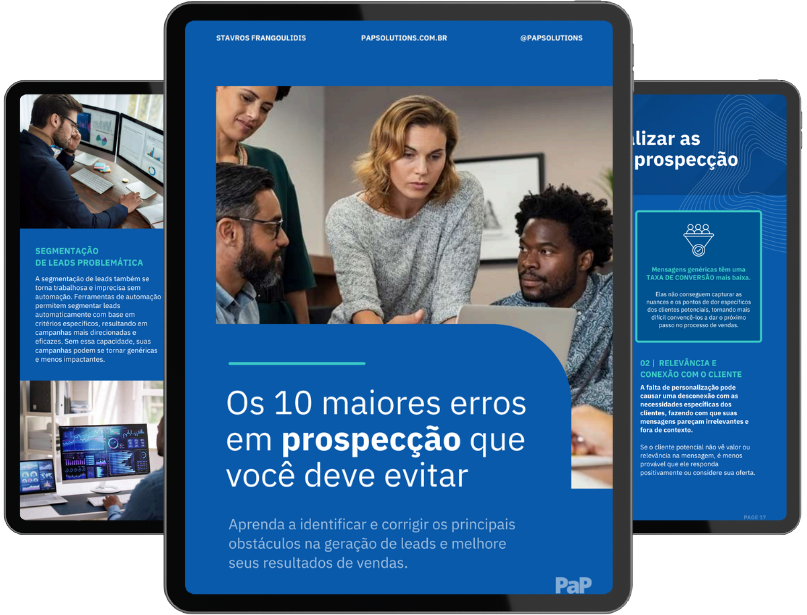Em vendas usamos a frase “Follow Up” para dizer “acompanhamento de um processo após a execução de uma etapa.”
Por exemplo:
Você emitiu uma proposta e aguarda por um retorno. Toda ação que você fizer, desde perguntar como está o processo decisório até enviar um e-mail com dicas complementares sobre aquilo que você vende, chamamos de follow up.
Você fez o follow daquela proposta? (Você deu prosseguimento, acompanhou o assunto daquela proposta emitida, como ficou?)
Outro exemplo é quando você agenda uma reunião e precisa organizar os próximos passos com ações que levem a oportunidade para um fechamento. Essas ações posteriores nós chamamos de follow ups.
Como ficou o follow daquela reunião? (Quais os próximos passos daquela reunião? O que será feito?)
Em processos de vendas corporativas, a grande maioria das situações de potencial negócio, não concluirá em vendas nos estágios iniciais.
Em prospecção, onde quem aborda o prospect é você, 90% das empresas que você abordará não estará interessada naquele momento para comprar o que você vende.
Você tem uma lista com 100 empresas. Entra em contato com todas. Estatisticamente, a probabilidade é que 10 delas demonstrem algum interesse em prosseguir e entre 1 e 3 fechem um negócio com você nos próximos meses.
A pergunta é: O que você faz com as 97 empresas que foram abordadas e não avançaram? Qual é sua estratégia de Follow Up?
Eu até tinha uma resposta para essa pergunta, mas os resultados eram muito baixos em termos de conversão em vendas.
A resposta era: Enfia essas empresas no mailing da Newsletter, ou seja, uma vez por mês essas empresas receberiam um informativo genérico, como um boletim de notícias, da nossa empresa.
Fizemos isso por anos a fio e nunca obtivemos resultados que pagassem a conta do esforço despendido. Não valia a pena e o processo era abandonado. Depois de alguns meses voltava, com uma nova estratégia de design ou um novo software de disparo ou mesmo com algumas alterações de conteúdo.
Posso contar pelo menos três tentativas que fizemos para colocar um sistema de relacionamento com os nossos públicos. Todas tinham fracassado.
Ao mesmo tempo, você tem as situações de conversão, onde você emite uma proposta e fica no aguardo de uma resposta, a qual estatisticamente também, não vem na maioria das vezes.
Como cobrar um retorno sem reduzir a sua imagem?
Não é conveniente para seu reforço de marca, você cobrar um retorno de uma proposta emitida ou retorno de algum e-mail.
Sim, é importante fazer o follow, mas dependendo como você o faz, passará a imagem de que está desesperado para vender e que lhe faltam clientes. Isso é péssimo para sua marca e para os negócios em geral.
Como fazer o follow sem cair nessa armadilha de percepção de extrema necessidade?
Mais uma situação muito corriqueira: Você troca cartões com uma pessoa muito interessante, mas nada combinaram para evoluir em uma possível aproximação para negócios.
Como manter essa pessoa por perto do seu radar e “aquecida” para aquilo que você vende?
Vinha procurando por essa resposta desde 2015, quando organizamos nosso database e contamos mais de 3 mil pessoas que passaram pelo nosso CRM e que estavam abandonadas em termos de “relacionamento”.
Criamos então as bases de um sistema que unisse a produção de conteúdo relevante (segundo a percepção do leitor) com sistemas automáticos, deixando de fora todos os outros elementos que até então eram imprescindíveis para um “bom marketing de relacionamento”, como por exemplo a segmentação.
Chamamos esse processo de Sistemas de Follow Up.
Testamos em algumas bases e depois de alguns ajustes, implementamos na nossa empresa para algumas bases isoladas.
Em agosto de 2017, fizemos um teste global, ou seja, implementamos o Sistema de Follow Up em todas as nossas bases, de leads, prospects, fornecedores, clientes, enfim, todos os nomes que estivessem em nossa base de dados.
E o resultado colhido em 30 dias foi de um aumento de 280% na geração de leads qualificados.
Sistemas de Follow Up hoje são uma realidade na nossa empresa e em algumas outras empresas que estão usando o modelo.

